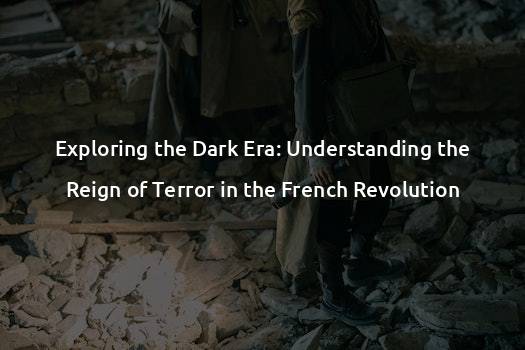Exploring the Dark Era: Understanding the Reign of Terror in the French Revolution
Exploring the Dark Era: Understanding the Reign of Terror in the French Revolution
The French Revolution, spanning from 1789 to 1799, was a time of profound social and political upheaval in France. It marked the end of the Bourbon monarchy and the rise of a republican government. Within this tumultuous period, one of the most infamous events unfolded: the Reign of Terror. This article delves into the roots of the Reign of Terror, its key players, and its lasting impact on history.
The Seeds of Unrest
Before delving into the Reign of Terror, it is crucial to understand the turbulent atmosphere that preceded it. The French Revolution was driven by a desire for political and social equality, as well as a need to overthrow the oppressive monarchy. The Revolution began with the storming of the Bastille, a symbol of royal authority, on July 14, 1789. This act of rebellion paved the way for a series of events that would forever alter the course of French history.
Amidst soaring inflation, food shortages, and an ever-widening wealth gap, the revolutionaries sought to establish a representative government that would cater to the needs of the people. Over the next few years, power changed hands multiple times. The monarchy was abolished, and a series of elected bodies, such as the National Convention, emerged in an attempt to stabilize the nation.
The Reign of Terror Begins
By 1793, the French Revolution had taken a radical turn. The execution of King Louis XVI in January of that year sent shockwaves across Europe. France was at war with several European powers, and internal divisions within the country were getting increasingly exacerbated. In this charged atmosphere, Maximilien Robespierre, a prominent revolutionary figure, emerged as a central figure in the Committee of Public Safety.
The Committee, established with the aim of protecting the revolution from foreign and domestic enemies, took on a more authoritarian role. Robespierre and his allies were determined to quell internal dissent and preserve the ideals of the revolution at any cost. This marked the beginning of the Reign of Terror.
The Mechanisms of Terror
The Reign of Terror was characterized by its systematic persecution of perceived enemies of the revolution. The Committee of Public Safety, led by Robespierre, wielded unchecked power. The Law of Suspects, passed in September 1793, authorized the arrest and execution of anyone suspected of counter-revolutionary activities. The Guillotine became the primary instrument of execution, symbolizing the brutal efficiency of the revolution.
The revolutionary government established revolutionary tribunals, which were responsible for conducting hasty trials that often resulted in swift sentencing and execution. The targets of these executions were varied, ranging from aristocrats and clergy to political rivals and even ordinary citizens suspected of disloyalty. The number of deaths during this period is estimated to be between 16,000 to 40,000.
Robespierre’s Downfall and the End of the Reign of Terror
Ironically, Robespierre himself eventually fell victim to the very terror he had unleashed. The Committee’s excessive violence and repression had alienated many. In July 1794, Robespierre was arrested and sentenced to death. This marked the end of the Reign of Terror, as the revolutionary fervor began to wane.
The end of the Reign of Terror represented a shift towards a more moderate phase of the Revolution. The Thermidorian Reaction, named after the month of Thermidor in the French Republican Calendar, saw a decline in the power of the Committee of Public Safety and a desire for more stability and order. The revolutionary government was restructured, and a new constitution was adopted in 1795, establishing the Directory as the executive power.
The Legacy of the Reign of Terror
While the Reign of Terror was short-lived, its impact was profound. It highlighted the dangers of unchecked power and the potential for violence within revolutionary movements. The excessive use of the guillotine, along with the suppression of individual liberties, left a lasting impression on both France and the world.
Yet, the Reign of Terror should also be seen as a byproduct of the complex circumstances of its time. It emerged as a response to existential threats faced by the revolutionaries and the need to protect their ideals. While their methods were extreme and morally questionable, the revolutionaries believed they were necessary to preserve the revolution.
TL;DR
The French Revolution’s Reign of Terror, led by Maximilien Robespierre and the Committee of Public Safety, was a period marked by widespread executions and intense repression. Driven by a desire to protect the revolution, this brutal chapter served as a cautionary tale of unchecked power. Despite its violent methods, the Reign of Terror left a lasting impact on history and reminded future generations of the fragility and complexity of revolutionary movements.







